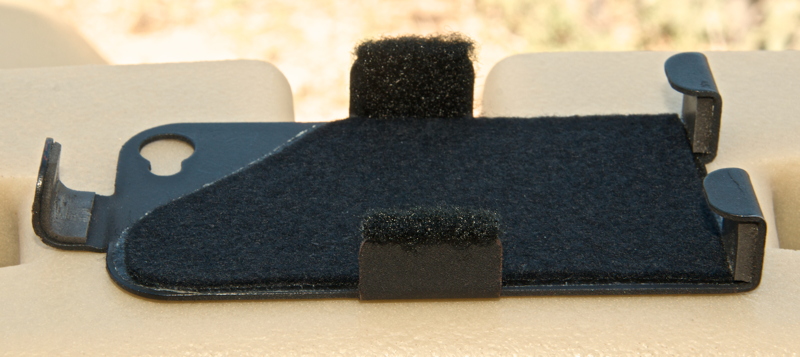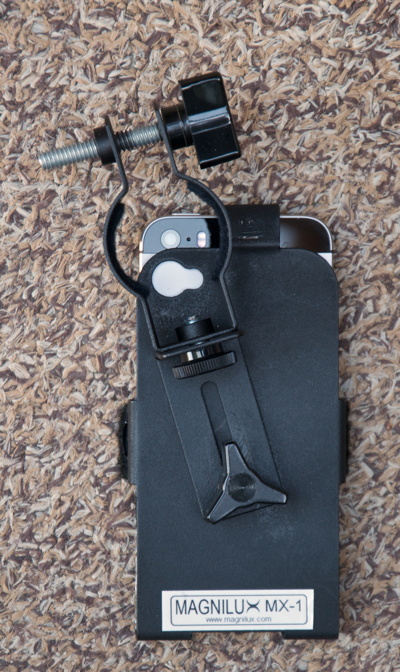Modified MX-1 iPhone Afocal Adapter,
Comet C/2014 E2 Jacques
Posted: 24 August 2014
Cloudy skies continued until Saturday, 23 August. Had another monsoon storm come through on Tuesday, 19 August, while I was at the Dark Skies and Emerging Technology Conference. It dropped 0.46" rain. My Conference report is now online.
|
Opened: Saturday, 23 August 2014, 1942 MST Temperature: 86°F |
Session: 710 Conditions: Mostly clear with some clouds in south |
1955 MST: viewed Mars, low in the southwest, 83X, then Saturn, also low in SW, 83X.
A tip that I discovered while reading the "Getting Started: Budget Astrophotography" book was to modify the Orion iPhone afocal adapter for use with the iPhone 5s. The modification required bending the top tab to accommodate the taller iPhone 5s (vs the shorter iPhone 4 that the adapter was designed for). Since I have the original Magnilux MX-1 iPhone Afocal Adapter, upon which the Orion adapter is based, I figured I could make the mod. First, I bent the top tab down flat and then bent about half back up. But that was not sufficient to securely hold the iPhone 5s as it is slightly narrower than the iPhone 4. So I added some soft-sided Velcro pieces to the side tabs. The next two photos show the bent top tab at the left and the added Velcro:


The iPhone 5s camera lens was above the adapter plate, as seen here:

As I prefer to use the earbuds/mic volume control as a "remote shutter release" with the iOS Camera app, one other modification was required since the headphone jack is on the bottom of the iPhone 5s:

The single bottom tab, the two side tabs (with Velcro pieces), and the modified top tab still hold the iPhone securely in the adapter.
This night I checked the modified MX-1 to see how well it worked. I discovered one glitch, which wasn't entirely related to the modification. When I tried to insert the 1.25" 9mm eyepiece into the TeleVue 2" 2X PowerMate 1.25" adapter, it would not go in. The 1.25" adapter was just slightly too large, as seen here:

However, the 1.25" adapter from the Meade 2" diagonal worked fine:

I tested the modified adapter using Saturn. This is a stack of 1122 iPhone slo-mo (120 fps) frames, 444X:

Seeing wasn't very good, so the image is not great. But as a test of the modified MX-1, it was a success. Optically aligning the iPhone was easier than when I would use my homemade afocal adapter.
2032 MST: I completed my modified MX-1 tests. Took a quick look at M16 (Eagle Nebula), 83X. I then did some software beta testing. While doing the tests I observed M20 (Trifid Nebula), M17 (Swan Nebula), and M22 (globular cluster). 2100 MST: completed software testing.
I then powered on the GC Wi-Fi Adapter and used SkySafari Pro on the iPhone 5s to GOTO to Comet C/2014 E2 Jacques, which was located in the constellation of Cassiopeia. The comet was a nice view at 83X, with a surprisingly bright large coma. No tail was visible however. It seemed appropriate that my first view of this comet from Cassiopeia Observatory would be when it was in Cassiopeia! I also viewed the comet in my 12x70 binoculars; very obvious object.
I added the focal reducer to the 8" LX200-ACF. I then mounted the D7000 DSLR at prime focus + focal reducer + star diagonal using a new 2" prime focus adapter I'm testing (review will be forthcoming). Did a focus test on the star Shedir (Alp Cas) using a Bahtinov Mask. Slewed back to Comet C/2014 E2 using SkySafari Pro and began taking 1, 2, and 3 minute exposures at various ISO settings. This is a 2 minute, unguided, ISO 5000, exposure:

The comet's motion caused it to slight trail during the exposure.
2219 MST: completed comet imaging. Did some more observing of Comet C/2014 E2 Jacques, 24mm UWA + focal reducer. This provided a very good of the large coma. Still no tail visible though.
My last task for the night was to take some comparison sky quality readings using a Unihedron SQM-L meter and the iOS app "Dark Sky Meter". The humidity was high so the readings were not very good this night. SQM=20.95; DSM=21.28. I reported the results to Globe at Night, the IDA, and the app developer.
It was great to be back in the observatory after a long absence due to cloudy skies and my conference trip.
|
Closed: Saturday, 23 August 2014, 2300 MST Temperature: 72°F |
|
18 August 2014 was the 5th Anniversary of "First Light" at Cassiopeia Observatory. In the past I have done some annual cleanup and maintenance at the observatory on this date, but this year I was at the "Dark Skies and Emerging Technology" conference. I plan to do the cleanup/maintenance as soon as the daytime humidity gets lower. It has been just too uncomfortable to work outside lately.
I have updated the Mementos Photos Album; check it out.
As you have probably noticed, the fixed Nav Bar buttons now appear at the top of newly updated pages. There was an issue with tablets when the fixed Nav Bar appeared beneath the Home Page photo, so I've now placed it at the top. Older pages on the Site do not have the fixed Nav Bar buttons.
Comments are welcome using Email. If you are on Twitter you can use the button below to tweet this report to your followers. Thanks.
Cassiopeia Observatory Home Page
Copyright ©2014 Michael L. Weasner / mweasner@me.com
URL = http://www.weasner.com/co/Reports/2014/08/24/index.html
